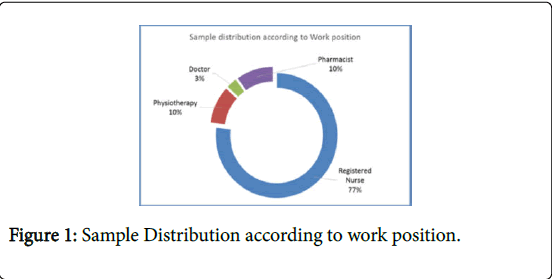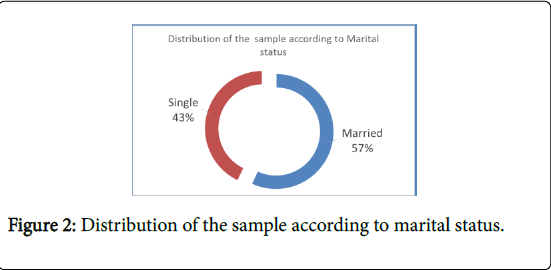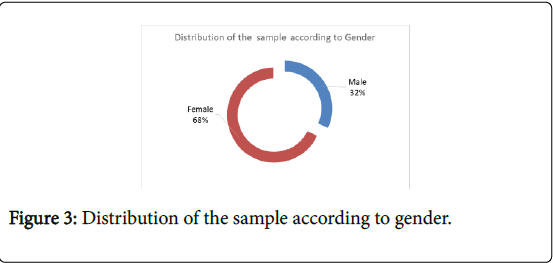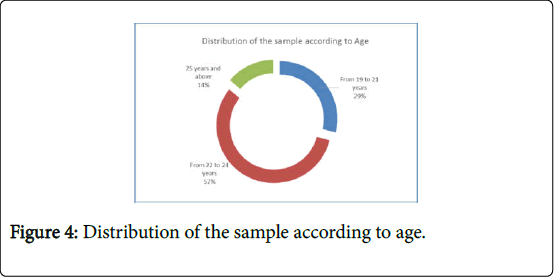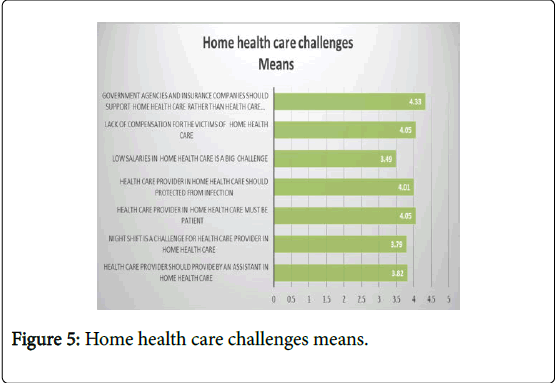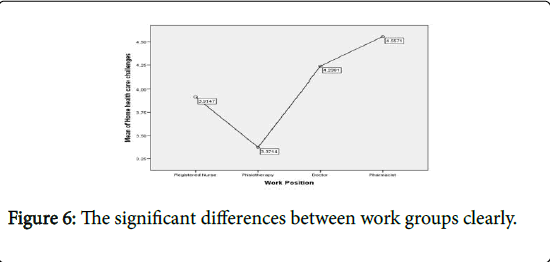Elderly Home Health Care Challenges among Health Care Provider in Riyadh at Nursing College Princess Nourah Bint Abdelrhman University
Received: 23-Jul-2018 / Accepted Date: 19-Apr-2018 / Published Date: 23-Apr-2018 DOI: 10.4172/2165-7904.1000607
Abstract
Home health care is a kind of health care provided in the home which is provided by licensed caregiver’s professionals who provide medical treatment needs. So the current study aimed to identify the challenges faced by health care provider for home health care among elderly in Riyadh City, Kingdom of Saudi Arabia. Descriptive design was used for this study among 100 home health care provider. A self-administered questionnaire was used after testing reliability and validity. The result revealed that 77% of the study sample was nurses and 68% was female. Majority of the respondents agree that Saudi community needs home health care. Support from Government agencies and insurance companies for home health care provider considered to be the most challenging. The study found that there was a high statistical significant difference in attitudes between the two groups of health care providers (Gender and Marital status) (with P value 0.10, 0.00 respectively). Home health care in Saudi Arabia is a significant need that merits support and attention.
Keywords: Home health care; Elderly; Challenges; Care givers
Introduction
Background
Health flied in Saudi Arabia have expanded and raised significantly during recent decades. The government of Saudi Arabia has given high priority to the development of health care services at all levels. In spite of that, a number of challenges faced the health care sectors, for example a shortage of Saudi health professionals, the health ministry's multiple roles, limited financial resources, changing patterns of disease, high demand resulting from free services, an absence of a national crisis management policy, poor accessibility to some health care facilities, lack of a national health information system, and the underutilization of the potential of electronic health strategies [1].
Home health care (HHC) is a kind of health care that can be given in patient’s home for different health problems, which provided by health expertise not only nurses. Home health care include wound care for pressure sores or a surgical wound, patient and caregiver education, intravenous or nutrition therapy, injections, and monitoring serious illness and unstable health status and finally for elderly (Medicare, n.d.). HHC should be distinct from home care. HHC is more health problems oriented toward helping clients regain control of health problems while, home care is regarding to domestic duties like cooking, cleaning and helping older persons with daily activities.
The volume of health care paying out are spent on hospital care and health team duties, everybody was looking for cutting costs in health care system by eliminates the unnecessary visits to health centers and unnecessary visits with physicians (Charness). Home health care (HHC) is cheaper than admission to medical centers. It helps in reduction the stay of length and hospital readmission which have the potential to reduce the costs and exposure to infection.
The highest percentage of patients who use HHC are elderly, The number of people aged 65 or older is projected to grow from an estimated 524 million in 2010 to nearly 1.5 billion in 2050, HHC duties are growing rapidly to cover the needs of the elderly population and those are suffering from many chronic illness which need the three levels of health care system. HHC have an impact on improving the quality of life among elderly patients in the home care setting [2,3].
In Saudi Arabia, the first HHC Program was developed at King Faisal Specialized Hospital and Research Center in 1991 for terminal cancer clients. In 2008, the Saudi Ministry of Health settled the HHC program which aiming to provide health services for all clients' needs care wherever they may be; in an endeavor to diminish the suffering of waiting in hospitals or moving to get the service". HHC services are provided according to the international standards and within the framework of Islamic values and traditions of the society (Saudi Ministry of Health, 2011).
The quality of health care provided in the home plays a major role in patient's life to restore or maintain the physical and mental functions. Therefore, the research purpose was to study the quality of home health care service and how far the service reaches in Riyadh city, Kingdom of Saudi Arabia. However, other HHC researchers focused on patients and their satisfaction with the provided service, this research concerned with health care team of the service. By researching for different articles the researcher found shortage in studying of the challenges that faced the health care provider. So the aim of the current is to identify the difficulties and challenges faced by health care provider for Home health care among elderly in Riyadh City, Kingdom of Saudi Arabia.
Aim of the study: The current study aimed to identify the challenges faced by health care providers for home health care among elderly in Riyadh City, Kingdom of Saudi Arabia.
Statement of the problem: Health care provider faced great challenges during home health care among elderly in Riyadh City; so this study investigated and will be determined these challenges. One of the biggest challenges faced by the nurse in home health care among elderly in Riyadh City is the traditions and habits of Saudi society which prevent health care providers to go to home health care.
Significance of the study: The importance of this study was an inventory of all challenges that facing health care providers in home health care among elderly in Riyadh City, Kingdom of Saudi Arabia, through which researchers put recommendations to reduce these challenges.
Through this research researchers clarified and give a good picture of home health care by highlighting that challenges among health care providers in Riyadh City, Kingdom of Saudi Arabia
Research questions
• What is the Importance of home health care which provided to elderly in Riyadh City from the perspective of home care providers?
• What is the Home health care challenges among health care providers who provided elderly care elderly in Riyadh City?
• Is there a statistically significant difference in participants attitudes towards home health care challenges among elderly in Riyadh City according to the demographic variables?
Material and Methods
The current study used descriptive research design. Descriptive can describe the actual sample of the study. But to extend the conclusions to a broader population, like all such classes, all workers, all women, we must be use inferential statistics.
The current study used descriptive research design. Descriptive can describe the actual sample of the study. But to extend the conclusions to a broader population, like all such classes, all workers, all women, we must be use inferential statistics.
n = N×P (1−P)/ [N−1× (d2/Z2)] + p (1−p)]
n: Sample size =100
N: Population size=135
Z: Confidence level at 95% (standard value of 1.96)
d: error proportion=0.05
P: the probability (30%−60%) or=50%
A self-reporting questionnaire administered to 100 HHC team. The questionnaire adopted by researcher through modifying the National Home Health Aide instrument (2007). It was concerned to study the following questions; demographic, characteristics of HHC visits and questions about eleven HHC challenges. Validity of the questionnaire done through three panel of expertise to test content, construction. Reliability piloted to the 10% of the study and measuring using Cronbach test which given a good Reliability by high value of 0.867.
The data for this research were collected using a survey questionnaire. The questionnaire was sent and filled individually after agreed the consent. The survey was comprised of 14 questions, which were related to the participant’s perception.
Reliability of the tools
Reliability was established using internal consistency with Cronbach’s alpha. A pilot experiment of the tools was performed on (30) health care provider, the calculated Cronbach's Alpha for the Questionnaire was (0.810) for the pilot-test and (0.867) for hole test. This result shown in Table 1 below.
| Sections | No. of phrase | A pilot-test | A Hole test |
|---|---|---|---|
| Section 2: Importance of home health care | 7 | 0.751 | 0.819 |
| Section 3: Home health care challenges | 7 | 0.756 | 0.76 |
| Overall Reliability | 14 | 0.81 | 0.867 |
Table 1: Reliability cronbach's alpha for the questionnaire.
From the above table, the researcher may be sure of the reliability of the questionnaires in which all values (>0.70), and thus became suitable for the application of the questionnaire for all samples.
Validity analysis
Pearson's correlation was conducted to assure the validity between each dimension and its subscales. Pearson's correlation coefficient indicates a statistically liner relationship between each dimension and its subscale for all dimensions, since the correlation coefficient (r)>0 and P-value ≤ 0.05 as shown in Tables 2 and 3.
| No | Dimension | Sub Scale | Pearson's Correlation (r) | Sig. |
|---|---|---|---|---|
| 1 | Section 2: Importance of home health care | 1- Do you think that home health care is needed in the KSA community? | 0.737** | 0 |
| 2- Do you agree to care your family health at home? | 0.771** | 0 | ||
| 3- Do you think home health care have advantage? | 0.724** | 0 | ||
| 4- Do you think home health care have positive image? | 0.450** | 0 |
Table 2: Pearson's correlation between research variables.
| No | Dimension | Sub Scale | Pearson's Correlation (r) | Sig. |
|---|---|---|---|---|
| 1 | Section 2: Importance of home health care | 5-Do you think home health care need specific skills and knowledge? | 0.573** | 0 |
| 6-Do you agree to work 12 hr shift in home health care? | 0.635** | 0 | ||
| 7-Do you agree to work part time job in home health care? | 0.698** | 0 | ||
| 2 | Section 3: Home health care challenges | 1-Health care provider should provide by an assistant in home health care | 0.763** | 0 |
| 2-Night shift is a challenge for health care provider in home health care | 0.792** | 0 | ||
| 3-Health care provider in home health care must be patient | 0.688** | 0 | ||
| 4-Health care provider in home health care should protected from infection | 0.735** | 0 | ||
| 5-Low salaries in home health care is a big challenge | 0.261** | 0.009 | ||
| 6-lack of compensation for the victims of home health care | 0.239** | 0.017 | ||
| 7-Government agencies and insurance companies should support home health care rather than health care facilities | 0.506** | 0 | ||
| **Correlation is significant at the 0.01 level (2-tailed). | ||||
Table 3: Pearson's correlation between research Variables Con't.
Statistical analysis
Descriptive statistics are used to describe the basic features of the data such as: Frequencies and Percentages, weighted Mean and Stander Division and Graphical chart. Inferential statistics are used to test the difference between groups is the study, and relation between variables, such as: T-Test (Independent Samples) will be used to answer the question: Is there a statistically significant difference in participants attitudes towards Home health care challenges among elderly in Riyadh City according Gender at level of significance 0.05. ANOVA test will be used to answer the question: Is there a statistically significant difference in participant’s attitudes towards Home health care challenges among elderly in Riyadh City according to the demographic variables (Age-work position-Marital status) at level of significance 0.05. These tests will be done through SPSS.
Result
Result of the study will be dived four sections. The first section general description of the sample (demographic data), 2nd section will answer the first question: which is what is the Importance of home health care which provided to elderly in Riyadh City from the perspective of home care providers?, 3rd Section will answer the 2nd question: what is the Home health care challenges among health care providers who provided elderly care elderly in Riyadh City?, 4th section will answer the 3rd question: Is there a statistically significant difference in participants attitudes towards home health care challenges among elderly in Riyadh City according to the demographic variables?.
General sample descriptive
The sample size of the health care providers that responded to the survey were 100 (N=100) respondents answered the survey. The background information of the sample was made up by four main questions which include: Work position, marital status, Gender and Age. This background information shown clearly in the next figures.
Figure 1 shows that the registered nurse had the highest percent 77% of respondents, followed by 10% for both physiotherapy and pharmacist, while the lowest percent 3% for doctor.
Figure 2 presents the distribution of the health care providers according to marital status, which shows that 57% of respondents were married as the highest percent, while the other 43% of the total sample were single.
Figure 3 presents the distribution of the health care providers according to gender, which shows that 68% of respondents were female as the highest percent of the total sample, while the other 32% of the total sample were male.
Figure 4 shows the distribution of the health care providers in terms of age, they were (22 to 24 years) with the highest percentage 57% of the total sample, the group of (19 to 21 years) with percentage 29%, and (25 year and above) with percentage 14% of the total sample.
Table 4 shows (Descriptive Statistics for Importance of home health care provided to elderly), from which the researcher find that the highest average was awarded to the question 1: (Do you think that home health care is needed in the KSA community?) with mean 4.53 ± 0.784, followed by question 3: (Do you think home health care have advantage?) with mean 4.47 ± 0.771.
| Questions | Strongly Agree | Agree | Neutrally | Disagree | Mean | Std. Deviation | Rank | |
|---|---|---|---|---|---|---|---|---|
| Do you think that home health care is needed in the KSA community? | N | 67 | 22 | 9 | 1 | 4.53 | 0.784 | 1 |
| % | 67% | 22% | 9% | 1% | ||||
| Do you agree to care your family health at home? | N | 45 | 37 | 16 | 2 | 4.25 | 0.796 | 4 |
| % | 45% | 37% | 16% | 2% | ||||
| Do you think home health care have advantage? | N | 61 | 28 | 8 | 3 | 4.47 | 0.771.771 | 2 |
| % | 61% | 28% | 8% | 3% | ||||
| Do you think home health care have positive image? | N | 15 | 26 | 48 | 8 | 3.42 | 0.944 | 6 |
| % | 15% | 26% | 48% | 8% | ||||
| Do you think home health care need specific skills and knowledge? | N | 39 | 20 | 28 | 10 | 4.41 | 0.652 | 3 |
| % | 39% | 20% | 28% | 10% | ||||
| Do you agree to work 12 hr shift in home health care? | N | 41 | 22 | 16 | 17 | 2.92 | 1.203 | 7 |
| % | 41% | 22% | 16% | 17% | ||||
| Do you agree to work part time job in home health care? | N | 42 | 29 | 23 | 4 | 3.68 | 0.983 | 5 |
| % | 42% | 29% | 23% | 4% | ||||
| Weighted mean | 3.95429 | |||||||
| Std. Deviation | 0.571385 | |||||||
Table 4: Descriptive Statistics for Importance of home health care provided to elderly.
While the lowest average was awarded to the question 4: (Do you think home health care have positive image?) with mean 3.42 and Std. Deviation 0.944, followed by question 6: (Do you agree to work 12 hr shift in home health care?) with mean 2.92 and Std. Deviation 1.203.
With strongly agree by percent (15%, 41% respectively) and agree by percent (26%, 22% respectively).
Table 5 shows (Descriptive Statistics for Home health care challenges) from which we find that the highest average was awarded to the statement 7: (Government agencies and insurance companies should support home health care rather than health care facilities) with mean 4.33 and Std. Deviation 0.9217, followed by statement 2 and 6: (Health care provider in home health care must be patient), (lack of compensation for the victims of home health care) with equal mean 4.02 and Std. Deviation (0.998,0.783) respectively, followed by statement 4: (Health care provider in home health care should protected from infection) with mean 4.01 and Std. Deviation 1.0395. With strongly agree by percent (54%, 26%, 42%, 47% respectively) and agree by percent (33%, 59%, 29%, 12% respectively).
| Statements | Strongly Agree | Agree | Neutrally | Disagree | Strongly Disagree | Mean | Std. Deviation | Rank | |
|---|---|---|---|---|---|---|---|---|---|
| Health care provider should provide by an assistant in home health care. | N | 39 | 20 | 28 | 10 | 3 | 3.82 | 1.149 | 4 |
| % | 39% | 20% | 28% | 10% | 3% | ||||
| Night shift is a challenge for health care provider in home health care. | N | 41 | 22 | 16 | 17 | 4 | 3.79 | 1.258 | 5 |
| % | 41% | 22% | 16% | 17% | 4% | ||||
| Health care provider in home health care must be patient. | N | 42 | 29 | 23 | 4 | 2 | 4.05 | 0.998 | 2 |
| % | 42% | 29% | 23% | 4% | 2% | ||||
| Health care provider in home health care should protected from infection. | N | 47 | 12 | 38 | 1 | 2 | 4.01 | 1.039 | 3 |
| % | 47% | 12% | 38% | 1% | 2% | ||||
| Low salaries in home health care is a big challenge. | N | 21 | 15 | 59 | 2 | 3 | 3.49 | 0.948 | 6 |
| % | 21% | 15% | 59% | 2% | 3% | ||||
| Lack of compensation for the victims of home health care. | N | 26 | 59 | 10 | 4 | 1 | 4.05 | 0.783 | 2 |
| % | 26% | 59% | 10% | 4% | 1% | ||||
| Government agencies and insurance companies should support home health care rather than health care facilities. | N | 54 | 33 | 7 | 4 | 2 | 4.33 | 0.921 | 1 |
| % | 54% | 33% | 7% | 4% | 2% | ||||
| Weighted mean | 3.9343 | ||||||||
| Std. Deviation | 0.60351 | ||||||||
Table 5: Descriptive statistics for home health care challenges.
While the lowest average was awarded to the statement 1: (Health care provider should provide by an assistant in home health care) with mean 3.82 and Std. Deviation 1.1492, followed by statement 2: (Night shift is a challenge for health care provider in home health care.) with mean 3.79 and Std. Deviation 1.2576, followed by statement 5 (Low salaries in home health care is a big challenge.) with mean 3.49 and Std.
Deviation 0.9481. With strongly agree by percent (39%, 41%, 21% respectively) and agree by percent (20%, 22%, 15% respectively).
The Weighted average of Section (3) was 3.9343 with Std. Deviation 0.60351, which indicate (Agree), as a general trend according to 5- point Likert scale since 3.9343 lie in the interval [3.41-4.20].
SO, the Home health care challenges among health care providers who provided elderly care in Riyadh City is a high level with average of 3.9343 lie in the interval of the High level: [3.41-5]. This results shown clearly in the below Figure 5.
Gender and marital status
To answer this question we use T-test to find out whether Home health care challenges among elderly in Riyadh City had an effect towards Gender and Marital status or not.
Table 6 was found that there was a highly statistically significant difference in attitudes between the two groups of health care providers (Gender and Marital status) (with P value 0.10, 0.00 respectively).
| Variables | N | Mean | S.D | T | Sig | |
|---|---|---|---|---|---|---|
| Gender | Male | 32 | 3.7098 | 0.54608 | 2.626 | 0.010* |
| Female | 68 | 4.0399 | 0.604 | |||
| Marital status | Married | 57 | 3.7469 | 0.61683 | 3.812 | 0.000* |
| Single | 43 | 4.1827 | 0.49026 | |||
Table 6: The relationship between gender marital status and home health care challenges (T-Test results).
Work position and age
A single ANOVA is required to determine if there are differences between multiple groups. Since a one-way analysis of variance (ANOVA) is used when we have a categorical independent variable (with two or more categories) and a normally distributed interval dependent variable and we wish to test for differences in the means of the dependent variable.
Table 7 shows that the F value of (8.199 and 5.668) Using α of 0.05 with p-value (0.000, 0.005) <0.05 conclude that there is a statistically significant difference among the population means. So there is significant differences between the health care providers according to their work position and Age in health care challenges among elderly in Riyadh City.
| ANOVA test results | N | Mean | Std. Deviation | F | Sig. | |
|---|---|---|---|---|---|---|
| work position | Registered Nurse | 77 | 3.9147 | 0.6093 | 8.199 | 0.000* |
| physiotherapy | 10 | 3.3714 | 0.1807 | |||
| Doctor | 3 | 4.2381 | 0.29738 | |||
| Pharmacist | 10 | 4.5571 | 0.04518 | |||
| Age | From 19 to 21 year | 29 | 3.6453 | 0.53673 | 5.668 | 0.005* |
| From 22 to 24 year | 57 | 4.0877 | 0.59746 | |||
| 25 year and above | 14 | 3.9082 | 0.57035 | |||
Table 7: The ANOVA results for the work position and age towards home health care challenges among elderly in Riyadh City.
Figure 6 shows that the significant differences between the health care providers according to their work position due to (doctor and pharmacist) which had the higher average among groups (4.55, 4.23) which Corresponding to (strongly agree) in Likert scale
Figure 7 shows that the significant differences between the health care providers according to their Age due to the group of (22 to 24 year) which had the highest average (4.08) among age groups.
Discussion
The Importance of home health care provided to elderly in Riyadh City from the perspective of home care providers sample is high level, this result is consistent with the nature of home care providers that they are wishing for the health improvement on the three levels. Almoajel et al. investigated the quality of home services in Riyadh Saudi Arabia and they found that 86.5% of home health care members stated the provided home health care service is an effective service that provides a noticeable improvement of patient’s condition [4].
Home health care needs specific skills and knowledge to give the health provider abilities for managing the health problems. The health provider provided care without any supervision almost of the time but in special cases there will be physician, So they must need special skills and knowledge to give them the ability of management. This result is accepted by Ellenbeckeret al. who’s investigated the patient safety and quality in home health care. They mentioned that home health care is a system of care provided by skilled practitioners to patients in their homes [5].
Home health care challenges among elderly health care providers was needing support and insurance from government agencies rather than health care facilities. This result from the perspective of the researcher due to customs and traditions in Saudi Arabia, from which the home health care challenges among elderly in Riyadh City statistically significant difference according to gender in favor of female group who’s had the highest average (4.0399).
Moreover the low salary, exposure for infection and lack of compensation for the victims of home healthcare were challenges for the participants. The home is not sterile area and any care giver can be exposed for infection and no agencies to overcome this infection. Most of researches studied difficulties and challenges that faced the home health care agencies not provider. Halvorson, reported the top 7 challenges faced the home health care agencies and he found increase demand, finding qualified personal, Regulation/Classification of Health Care Agencies, Advances in Technology, Keeping qualified Staff, payment and political pressure [6].
Also, the home health care challenges among elderly in Riyadh City statistically significant difference according to marital status in favor of single group whose had the highest average (4.1827). The result of this study are consistent with the results of the study of "Health care system in Saudi Arabia: an overview" [7-14].
Recommendation
Nursing implication
The decision to hire a home healthcare worker can be a difficult decision for many families. It takes a certain level of trust to allow someone into a patient’s home and provide medical care to an ailing, injured, or recovering family member, especially if there are no other family members around to supervise the care or check in on the individual receiving care. Thankfully, many home healthcare agencies hire exceptionally caring and compassionate professional staff. Additionally, these staff members have also undergone extensive background and reference checks, in order to provide extra peace of mind to the patient and family members who are allowing an individual into their homes. Working to establish that special level of trust between the home nurse, the patient, and the family is something unique to home healthcare.
In addition to trust, another unique aspect of the home healthcare provided by a home health or Private Duty nurse is the bond established between patient and caregiver. Nurses provide a form of companionship to the patient which, in turn, helps to lessen the effects that loss of independence and social isolation can have on the sick or injured individual. In many cases, the home nurse helps to boost the morale of the patient which aids in the healing process. Patients feel the comfort of being able to recover at home while still receiving medical care, and in many cases, start to see the home nurse or private duty nurse as an important visitor in their routine. Some patients even begin to feel that their nurse is a friend or “another one of the family” due to the comfort and level of care received.
References
- Almalki M, Fitzgerald G, Clark M (2001) Health care system in Saudi Arabia: An overview. J Eastern Mediterranean Health 17: 784-793.
- Modeer MA, Hassanien NS, Jabloun CM (2013) Profile of morbidity among elderly at home health care service in Southern Saudi Arabia. J Family Commu Med 20: 53-57.
- Bayazidi S, Zarezadeh Y, Zamanzadeh V, Parvan K (2012) Medication error reporting rate and its barriers and facilitators among health care provider. J Caring Sci 1: 231-236.
- Almoajel, A, Al-Salem, A, Al-Ghunaim, L, Al-Amri, S (2016) The quality of home healthcare service in riyadh/saudi arabia. Asia J Natu Appl Scie 5: 2.
- Ellenbecker CH, Samia L, Cushman MJ, Alster K (2008) Patient safety and quality in home health care. Agency for Healthcare Research and Quality (US).
- Halvorson C (2013) Top 7 challenges facing home health care agencies in 2013
- Almalki M, Fitzgerald G, Clark M (2001) Health care system in Saudi Arabia: An overview. J Eastern Mediterranean Health 17: 784-793.
- Allen D (2016) The importance, challenges and prospects of taking work practices into account for healthcare quality improvement. J Health Organ Manag 30: 672-689.
- Alduais AMS, Mogali S, Al Shabrain B, Al Enazi A (2014) Barriers and strategies of reporting medical errors in public hospitals in Riyadh city: A survey-study. J Nur Health Sci 3: 72-85.
- Bayazidi S, Zarezadeh Y, Zamanzadeh V, Parvan K (2012) Medication error reporting rate and its barriers and facilitators among health care provider. J Caring Sci 1: 231-236.
- Johari H, Shamsuddin F (2013) Medication errors among health care provider in government hospital. J Nurs Health Sci 1: 18-23.
- Johnson J, Thomas M (2013) Knowledge and attitude of health care provider in Ajman, UAE. Reviews of Progress. Reviews of Progress 1: 2321-3485.
- Kalantarzadeh M, Hosseinnejad M (2014) Underreporting of medication errors in nursing students: A threat to patient safety. J Med Ethics Hist Med 7: 11.
- Modeer MA, Hassanien NS, Jabloun CM (2013) Profile of morbidity among elderly at home health care service in Southern Saudi Arabia. J Family Commu Med 20: 53-57.
Citation: Alsenany SA, Farag MK, Alanazi ST (2018) Elderly Home Health Care Challenges among Health Care Provider in Riyadh at Nursing College Princess Nourah Bint Abdelrhman University. J Community Med Health Educ 8: 607. DOI: 10.4172/2165-7904.1000607
Copyright: © 2018 Alsenany SA, et al. This is an open-access article distributed under the terms of the Creative Commons Attribution License, which permits unrestricted use, distribution, and reproduction in any medium, provided the original author and source are credited.
Share This Article
Recommended Journals
Open Access Journals
Article Tools
Article Usage
- Total views: 5294
- [From(publication date): 0-2018 - Nov 23, 2024]
- Breakdown by view type
- HTML page views: 4448
- PDF downloads: 846

